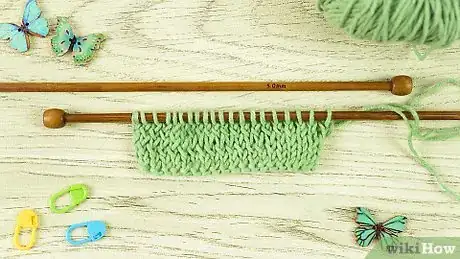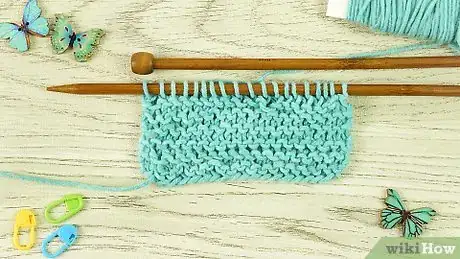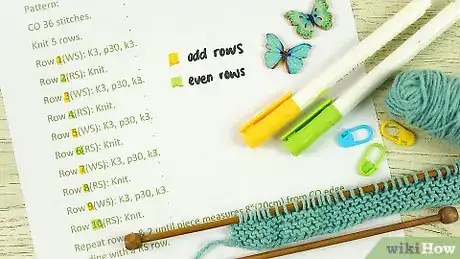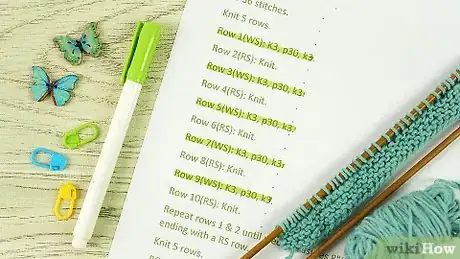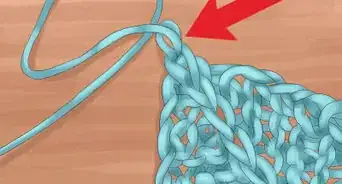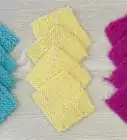This article was co-authored by Jen Webber and by wikiHow staff writer, Amber Crain. Jen Webber is a Knitting Specialist and the Manager of The Quarter Stitch, a crafting store based in the French Quarter of New Orleans, Louisiana. With over 17 years of knitting and crafting experience, Jen helps educate customers and the public on best knitting practices for their DIY projects.
There are 10 references cited in this article, which can be found at the bottom of the page.
This article has been viewed 94,572 times.
If you're a knitting newbie, you may be confused when a pattern tells you to knit on the right side (RS) or wrong side (WS). Don't worry—it's confusing to everyone at first! Basically, the right side (RS) is the front side of your project. When the pattern says to work a row (RS), it means that row will face the front. The wrong side is the back side, so if a pattern says to work a row (WS), that row will face the back side of the completed project.
Steps
Inspecting the Stitches
-
1Look for rows of raised, wavy stitches to find the wrong side. Wavy stitches are called purl stitches and purling always appears on the wrong side of the work. If you see wavy purl stitches, you're looking at the wrong side. The side with flat braided stitches is the right side (or the knit side).[1]
- The right side feels flatter and smoother than the wrong side.
-
2Use the first row to identify the right side if the sides look identical. Garter stitch patterns won't have wavy purl stitches on the wrong side. Instead, both sides of the work look identical.[2] To find the right side, check where your cast on tail is after knitting the first row. When the cast on tail is in that position, you're looking at the right side of the work.[3]
- The first row and every odd numbered row after that is right side facing.
- For non-garment items, like toys or blankets, consider the piece reversible. Either side can be the right side.
Advertisement -
3Check for columns of wavy, bumpy stitches to identify the wrong side. Ribbing patterns have vertical, alternating columns of knit and purl stitches. The side with vertical rows of wavy purl stitches is the wrong side.[4]
-
4Find a row with a gap to identify the wrong side of multi-colored work. If the swatch has more than 1 yarn color, look closely at the row where 1 color changes to the next color. The side that shows a row with a small gap in between the colors is the wrong side. The right side looks like normal and has no gaps between the rows.[5]
- This trick works for any stitch with identical-looking, like the garter stitch.
-
5Look for loose yarn to spot the wrong side. When you’re knitting a specific pattern with multiple color changes, it’s easy to tell the sides apart! The right side is the side with the stitching and colorful pattern on it. The wrong side has loose strands of yarn and the stitches look random.[6]
Reading Pattern Instructions
-
1
-
2Flip the work over at the end of each row to work on the reverse side. When all of the stitches on 1 needle have been transferred to the other needle, you've reached the end of a row. Flip the work and place the needle with the stitches on it in your left hand and start the next row.[9]
- For example, if you're knitting stockinette, flip the work when you reach the end of the first row and do the next row with purl stitches. The pattern directions might look like:
- Row 1 (RS): Knit.
- Row 2 (WS): Purl.
- For example, if you're knitting stockinette, flip the work when you reach the end of the first row and do the next row with purl stitches. The pattern directions might look like:
-
3See if even and odd rows are labeled on the pattern. The first row of a knitting pattern is considered the right side, and the second row is considered the wrong side. Since one is an odd number, all of the odd rows are right side facing. The even rows are on the wrong side.[10]
-
4Highlight odd rows on the pattern to track which side is which. If your pattern doesn’t label the rows as even or odd, simply find the first row on the paper pattern and highlight it. Then, highlight all of the odd numbered rows after that. That way, when you’re looking at the pattern, you know the highlighted rows are right side facing and the even rows are wrong side facing.[11]
- For example, you would highlight this on your pattern since it’s the first row:
- Row 1 (RS): K1, kfb, knit to end [1 st inc].
- For example, you would highlight this on your pattern since it’s the first row:
Expert Q&A
Did you know you can get premium answers for this article?
Unlock premium answers by supporting wikiHow
-
QuestionHow do I know which is the right side of my knitting?
 Jen WebberJen Webber is a Knitting Specialist and the Manager of The Quarter Stitch, a crafting store based in the French Quarter of New Orleans, Louisiana. With over 17 years of knitting and crafting experience, Jen helps educate customers and the public on best knitting practices for their DIY projects.
Jen WebberJen Webber is a Knitting Specialist and the Manager of The Quarter Stitch, a crafting store based in the French Quarter of New Orleans, Louisiana. With over 17 years of knitting and crafting experience, Jen helps educate customers and the public on best knitting practices for their DIY projects.
Knitting Specialist
-
QuestionWhat does it mean when a pattern says end on right side?
 wikiHow Staff EditorThis answer was written by one of our trained team of researchers who validated it for accuracy and comprehensiveness.
wikiHow Staff EditorThis answer was written by one of our trained team of researchers who validated it for accuracy and comprehensiveness.
Staff Answer wikiHow Staff EditorStaff Answer
wikiHow Staff EditorStaff Answer -
QuestionMy hat pattern calls for knitting in the round and says pattern is worked on the wrong side. Does that mean I turn it inside out to wear it?
 wikiHow Staff EditorThis answer was written by one of our trained team of researchers who validated it for accuracy and comprehensiveness.
wikiHow Staff EditorThis answer was written by one of our trained team of researchers who validated it for accuracy and comprehensiveness.
Staff Answer wikiHow Staff EditorStaff Answer
wikiHow Staff EditorStaff Answer
References
- ↑ http://classes.kvcc.edu/students/~rshephard8656/final/stitches.html
- ↑ http://classes.kvcc.edu/students/~rshephard8656/final/stitches.html
- ↑ https://nattyknitter.wordpress.com/2013/10/30/how-to-tell-right-from-wrong-in-garter-stitch/
- ↑ https://blog.nobleknits.com/blog/2018/10/17/how-many-types-of-knitting-are-there
- ↑ https://www.youtube.com/watch?v=2ydfl5i8r2Y&feature=youtu.be&t=55
- ↑ https://www.youtube.com/watch?v=2ydfl5i8r2Y&feature=youtu.be&t=61
- ↑ https://www.ling.upenn.edu/~beatrice/knitting/
- ↑ http://www.craftyarncouncil.com/tip_knit.html
- ↑ https://digitalcommons.usu.edu/cgi/viewcontent.cgi?article=2480&context=extension_curall
- ↑ https://nattyknitter.wordpress.com/2013/10/30/how-to-tell-right-from-wrong-in-garter-stitch/
- ↑ https://blog.nobleknits.com/blog/2018/4/9/which-side-of-my-knitting-is-the-right-side
- ↑ Jen Webber. Knitting Specialist. Expert Interview. 4 August 2020.
